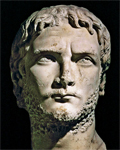HORTI LICINIANI
The Licinian Horti belonged to the gens Licinia, an ancient plebeian family, who became famous when around 370 BC Gaius Licinio Calvo Stolone, tribune of the plebs, along with colleague Lucio Sesto Lateran, fought a bitter battle, that after five years of conflict led to the passing of law Licinian-Sestie.
In the Roman Republic the highest level of executive power was entrusted, for a year, to two consuls, until then, patricians. With the approval of the new law one of the consuls had to be plebeian. The Gentes, namely families, patrician consisted of those who, according to the historian Livy, were the descendants of those Patres (hence patricians) who were part of the Roman Senate established by Romulus.
To these later joined the gens Claudia, who, once approved the law Licinia-Sestia, thought it well to stand in two branches: the Claudio Pulcri, patricians and the Claudio Marcelli, plebeians. To switch between patricians to plebeians was enough being adopted by a plebeian.
Along the centuries the gens Licinia divided into two branches: the Licinii Luculli, whose most famous member was Lucius Licinius Lucullus, great leader and consul in 73 BC and Licinii Crassi among whom excelled Marcus Licinius Crassus,
consul in 70 and in 55 BC and triumvir with Caesar and Pompeius.
Crassus remained famous for his great wealth and for the sake of salacious joke, remember that when the herald announced the arrival of Pompeius the Great, said: "How much great?"
Centuries pass the republic wanes, imposes the empire and in 253 Publius Licinius Valerian, become Emperor, shared the lead with his son Gallienus.
 |
 |
 |
Marcus Licinius Crassus |
Pompeius |
Gallienus |
Valeriano died in 260 Gallienus reigned until 268, then ruled the empire for 15 years.
When he reigned alone issued a series of edicts ensuring freedom of worship to Christians.
Returning to the Horti, Gallienus, a great lover of art and philosophy, expanded the existing Licinian, incorporating those Tauriani, then in our visit we will see them together.
The perimeter of the Licinian Horti was not clearly defined, however, had to be extended from the Tiburtina gate,
include the area where today is located (oppressed by the railway and defaced by vandals) the church of Santa Bibbiana,
continue until the so-called Temple of Minerva Medica,
which actually was a nymphaeum and get up on the Labicana street.
The visit to Licinian Horti starts at the Montemartini Museum, where has been reconstructed the grand mosaic with hunting scenes,
showing us those exotic animals much appreciated by the Romans.
In the same environment do not miss the impressive girl sitting,
Roman replica of an Hellenistic original of the third century BC, then two statues of Dionysus, inspired by Hellenistic models, but not copies.
The two magistrates,
magnificent the elder,
hold the drape. With its launch departed races in the circus.
And yet a satyr, the alluring dancing satyr, inspired by models of the middle Hellenistic period.
A capital with Dionysian scenes it suggests the refinement of the environment.
The visit continues in the Capitoline Museums where we find the emperor Hadrian, well arranged: on the left the mother-in-law Matidia, right the beautiful wife Sabina.
The novel of Marguerite Yourcenar "Memoirs of Hadrian", published in 1951, was very successful, but to be honest the historical reality to the author cares little or nothing.
Too many movies and novels have been published and products for the consumption of our times, without even trying to understand what were the costumes, the thought, the feeling of the ancient world.
Back to our Adriano, or better yet to Salonina Matidia, daughter of Ulpia Marciana, sister of Marco Ulpius Trajan.
Trajan and his faithful wife Plotina not having children, poured their love on Salonina Matidia, loved and educated as a child, to the point that in the 116 was nominated Augusta.
Matidia from her first husband Lucio Vibio Sabino had two daughters of whom Vibia Sabina married Adriano. From the convergence of various clues it is plausible that Adriano married Sabina following Plotina hot suggestion, Trajan then adopted him and at his death in 118, Hadrian became emperor. In 128 the same Adriano named Vibia Sabina Augusta, who also was the owner of the famous Villa Adriana. She died around 137 and was deified by Hadrian,
as had been deified in 119, again by Hadrian, Matidia. Hadrian died in 138.
Continuing our visit we find the beautiful Aphrodite, from the fourth century BC original of Kephisodotos of which we know little. Incidentally his works in bronze were melted, then we know him only for the Roman replica. He is considered, by many, the father of the great Praxiteles. And Roman replica from Praxiteles school of the fourth century is the Young girl.
Other beautiful Roman replicas are in the same environment with the famous cow of Myron, the bronze original of which was on the Acropolis of Athens.
back |

